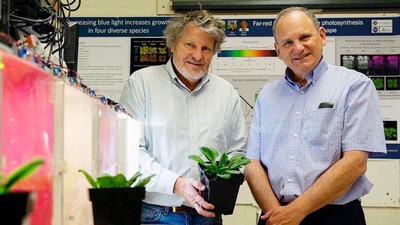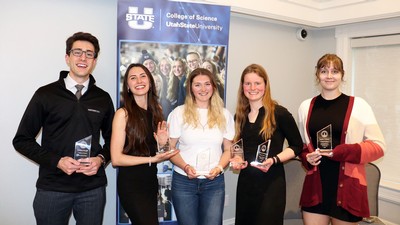USU Student Uses Undergraduate Research Grant to Train AI for Weeding
By Ethan Brightbill |
The artificial intelligence revolution is coming, and there is nowhere to hide — at least, not for weeds.
Third-year computer science major Andrew Jouffray is working with assistant professor Rakesh Kaundal of Utah State University to develop software that will allow machines to identify and remove weeds without human involvement. Instead of a programmer specifying exactly what a weed looks like, Jouffray and Kaundal are helping one computer to teach another computer.
“Currently, training a computer to detect objects in an image requires humans to go over thousands of images and ‘draw boxes’ around the objects the computer must learn to detect,” said Jouffray. “This method is very slow, so having a computer do it for us could save months of work.”
The results are impressive.
“While a human takes 15 to 45 seconds on average to go through an image and mark out all the object of interest, our system can do it in 0.05 seconds,” said Jouffray. “A computer trained on images generated by my system has achieved 77 percent accuracy in locating and identifying fruit.”
Jouffray and Kaundal aim to create a dataset of roughly 250,000 images. To do that, they are in the process of gathering images of a range of plant types. A computer then creates numerous modified copies of each image, which then helps another computer identify different plants even under chaotic conditions outside of a lab.
Kaundal sees great potential for the project.
“Allowing farmers to quickly monitor and control the spread of weeds in their fields without having to rely on harmful chemicals can reduce the cost of organic-grown food and help in maintaining healthy soils and aquifers,” Kaundal said.
The project contributes to the advancement of precision agriculture — that is, using data to make farming more efficient, sustainable and productive.
“The method we’re developing is not limited to weeds,” said Kaundal. “It could be used to monitor crop health, locate fruits and vegetables for harvest and more. Robotic precision agricultural systems could assist in reducing the workforce for large farms and allow for the expansion of those farms to meet the growing demand for food security.”
Although computers and agriculture are not often thought of together, Jouffray had an interest in both at an early age. He maintained a vegetable garden with his mother while growing up in southern France before studying computer science.
Kaundal himself has a doctorate in plant breeding and genetics, a post-graduate degree in bioinformatics, and an adjunct position with the Department of Computer Science in addition to leading the Kaundal Artificial Intelligence and Advanced Bioinformatics Lab at Utah State. He believes there are many advantages to working across disciplines.
“One of the benefits is a more holistic understanding of the world,” said Kaundal. “Different perspectives help students to deal with real-world problems. It also hones their collaboration skills. When students graduate, they work with people from across the world with diverse backgrounds, so why should higher education be any different? College is not only about gaining advanced knowledge, but also learning more about yourself, nurturing your passions, discovering your interests and growing as a student and individual in society.”
By that measure, Jouffray is already making the most of his education.
“I love solving problems that can make an impact in the world.” Jouffray said. “Seeing a computer recognize objects that it has never seen before, and knowing that machines in the future might be able to learn on their own to harvest and weed crops, is such a rewarding feeling.”
Jouffray’s work also might not stop with plants.
“I would love to apply my technology to trash detection,” said Jouffray. “If that can make an impact in cleaning up the world, it would be wonderful.”
The project was made possible by an Undergraduate Research and Creative Opportunity grant from Utah State’s Office of Research, which provides students with a one-semester, $1,000 scholarship for conducting original research or creative work under the guidance of a faculty mentor. Jouffray’s worked with plant scientist Steve Young before joining Kaundal, and his bioinformatics research will continue beyond the initially funded semester.
Undergraduate researcher Andrew Jouffray's work uses artificial intelligence to enable robots to identify weeds and distinguish them from crops.
WRITER
Ethan Brightbill
Writer and Marketing Assistant
College of Veterinary Medicine
Ethan.Brightbill@usu.edu
CONTACT
Rakesh Kaundal
Associate Professor and Director
Department of Plants, Soils and Climate/USU Bioinformatics Facility
rkaundal@usu.edu
TOPICS
Research 879stories Grants 228stories Agriculture 225stories Plants 188stories Undergraduate Research 157stories Technology 141stories Farming 77storiesComments and questions regarding this article may be directed to the contact person listed on this page.









